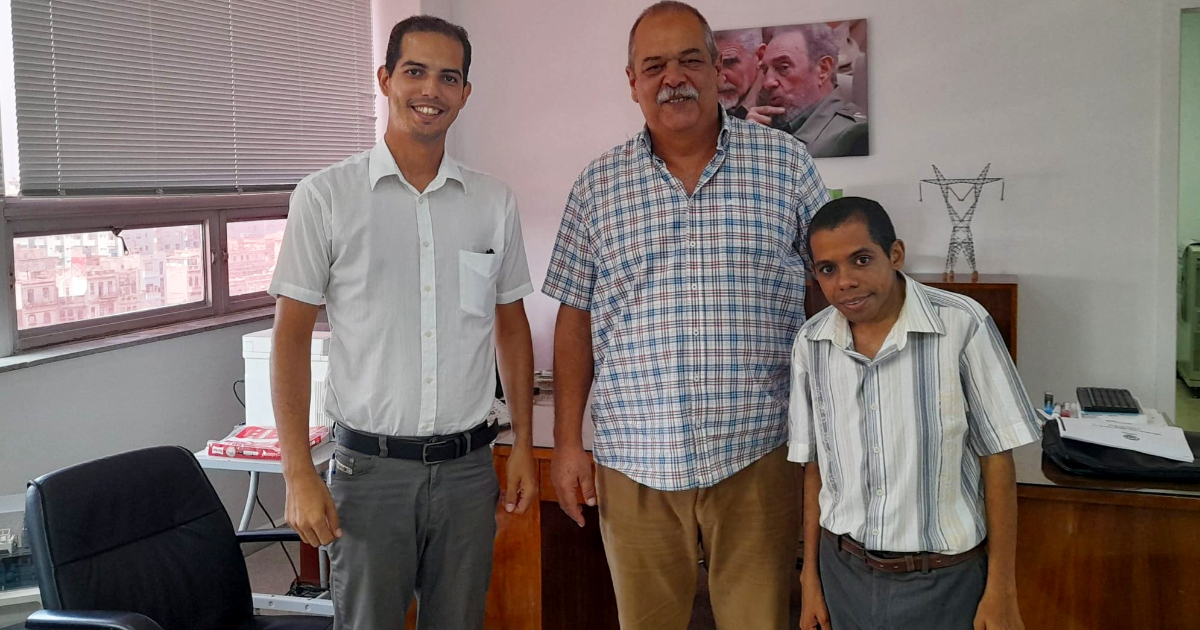The deputy for the municipality of Sagua de Tánamo in Holguín, Yusuam Palacios Ortega, met with the Minister of Energy and Mines, Vicente de la O Levy, to assess the ministry's plans regarding energy supply in the area. This was shared on social media by Diego Antonio de la Torre Castro, a functionary of the Fragua Martiana Museum and executive secretary of the José Martí Cultural Society, who was present at the meeting.
"Sensitivity, commitment, no rest, total dedication; these qualities characterize our Minister of Energy and Mines Vicente de la O Levy, a sentiment reflected in the rest of the sector's workers," De la Torre Castro proclaimed in a Facebook post, sharing a photograph taken during the meeting. According to his words, the deputy reviewed "issues related to the organization, corresponding to Sagua de Tánamo."
"We are working hard, with innovative ideas, great effort. A lot of heart, convinced that together we will move forward," concluded the official, without providing any information on the content or outcome of the meeting.
The regime's propagandists are very busy these days, trying to generate a current of opinion that neutralizes the dissatisfaction spreading among the Cuban public. For now, the indignation finds its main outlet through social media, where Cubans go to complain about the unbearable blackouts, shortages, inflation, and the widespread crisis that extends poverty and social exclusion to ever wider layers of the population.
Potential for Spontaneous Protests
However, civil society warns that this growing discontent could find other channels and lead to spontaneous protests, as has happened on previous occasions in critical contexts like the current one, where Cubans have taken to the streets to express their anger over blackouts and the collapse of public services. The regime itself is aware of this and even considers it a possibility, as shown by the Ministry of the Interior (MININT) on its social media in mid-April. According to the regime's most repressive institution, the possible scenario is the fault of the U.S. government and American politicians who incite public disorder.
In mid-December of last year, Palacios Ortega criticized Cuban civil society critical of the regime, calling them "low-souled beings" for what he considered their lack of ethics in attacking the government. Palacios Ortega outlined the qualities that, in his opinion, an opponent should have: "The opposition, if it is genuine, points out errors, makes proposals, but with dignity and ethics."
Known for being one of the most ardent defenders of the Cuban regime, and for unusual and absurd interventions that have placed him at the center of criticism and ridicule on Cuban social media, Palacios Ortega's statements continue to be a source of sarcasm. Removed in January 2023 as president of the Martian Youth Movement, Palacios Ortega continues his propagandistic work as a deputy of the National Assembly of People's Power (ANPP), representing the voters of Sagua de Tánamo.
Three days before the protests on March 17 (17M), outraged Cubans due to constant and prolonged blackouts broke the windows of the Panamericana Store "La Montañesa" in Sagua de Tánamo. In September 2023, it was known that Holguín was the Cuban province where most photovoltaic parks would be built from a Chinese donation of more than $114 million. The municipalities of Banes, Sagua de Tánamo, Rafael Freyre, Urbano Noris, Gibara, and the provincial capital were chosen to host the installations.
However, to date, the million-dollar Chinese donation has been of no use, given the evidence indicating that in Sagua de Tánamo, as in most municipalities in the country (especially those in eastern Cuba, but also in the capital), prolonged and daily blackouts continue. Before the 17M outbreak, reports on social media indicated that in other localities of the country, Cubans were also protesting against the widespread crisis and blackouts of up to 17 hours a day.
The people protested in the streets of Holguín, and in Camagüey, several Cubans broke the windows of stores and a polyclinic. In Cienfuegos, a young man took to the street with a machete and destroyed a government-owned car. Anti-regime posters appeared in Havana and several areas of Artemisa, especially in San Antonio de los Baños and Alquízar.
Understanding Cuba's Energy Crisis and Public Discontent
The ongoing energy crisis and public discontent in Cuba have led to significant unrest and spontaneous protests. Here are some frequently asked questions to help understand the situation better.
What triggered the recent protests in Cuba?
The recent protests were triggered by constant and prolonged blackouts, widespread shortages, inflation, and the general crisis affecting everyday life in Cuba.
What was discussed in the meeting between Yusuam Palacios and the Energy Minister?
The meeting focused on assessing the ministry's plans regarding energy supply in Sagua de Tánamo, although no specific details or outcomes were disclosed.
How has the Cuban government responded to the protests?
The Cuban government has blamed the U.S. government and American politicians for inciting public disorder, while also attempting to create a narrative to neutralize public dissatisfaction.
What is the significance of the Chinese donation for photovoltaic parks?
The Chinese donation of more than $114 million was intended to build photovoltaic parks in Holguín, aiming to improve the energy situation. However, the benefits of this donation have not been realized as blackouts continue.
